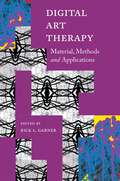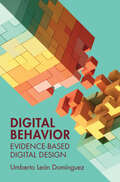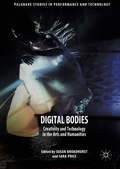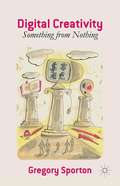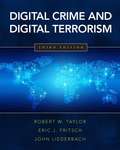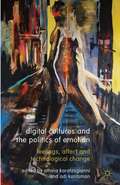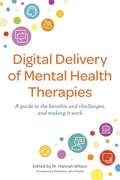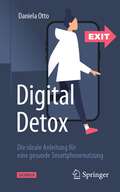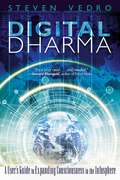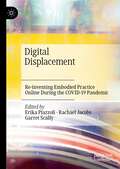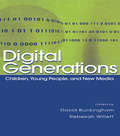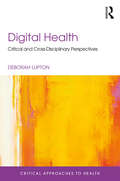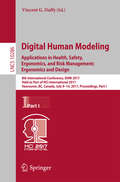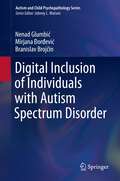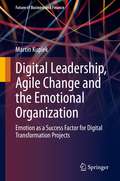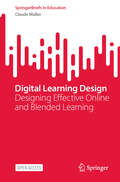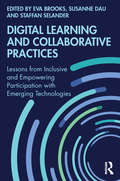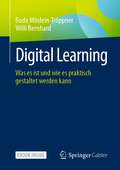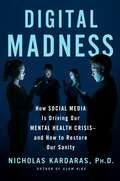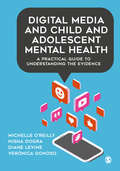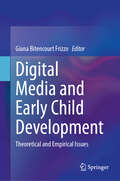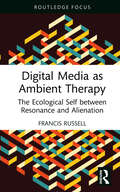- Table View
- List View
Digital Art Therapy: Material, Methods, and Applications
by Brittany Barber Catherine Hsin Christian Brown Christina Vasquez Gretchen Miller Jon Ehinger Jukka Laine Katie Hall Kelly Darke Nancy S. Choe Natalie Carlton Noel L'Esperance Rachel Brandoff Reina Lombardi Rick GarnerConsidering the latest advances and developments in the arena of digital media, this book explores current materials, methods and applications of digital technology in art therapy. It looks thoroughly at the many potential uses and benefits of digital technology in art therapy practice, including the use of stop motion animation and therapeutic light painting photography. A worked example of how digital art therapy can be used in the treatment of traumatic brain injury is also included. The book explores innovative therapeutic uses of digital technologies such as gaming and virtual worlds. Contributions from experienced art therapists address professional and ethical issues, from the sensory qualities of digital media and their effects in practice, to identifying and using developmentally appropriate technologies. As art therapy programs increasingly recognize the importance of using digital media, this cutting-edge guide provides all the necessary knowledge to incorporate this emerging field into practice.
Digital Behavior: Evidence-Based Digital Design
by Umberto Leon DominguezIn a technologically advanced and competitive landscape dominated by major tech companies and burgeoning start-ups, the key asset lies in boosting monthly active users. Traditionally, product design has relied on fragmented insights from personal experience, common sense, or isolated experiments. This work endeavours to establish a theoretical framework for predicting and influencing the digital behaviour of technology users. Drawing on over a century of scientific research in behaviour, cognition, and physiology, this presents a comprehensive approach to customizing digital stimuli. The objective is to enhance user interactions with digital and virtual environments. Through real and cost-effective examples, diagrams, and formulas, the text offers theoretical knowledge and a practical methodology to elevate digital product designs, setting them apart from the competition. With the potential to reshape the digital design landscape, this book emerges as a game-changer, promising to revolutionize how digital products and services are conceived and delivered.
Digital Bodies
by Sara Price Susan BroadhurstThis book explores technologies related to bodily interaction and creativity from a multi-disciplinary perspective. By taking such an approach, the collection offers a comprehensive view of digital technology research that both extends our notions of the body and creativity through a digital lens, and informs of the role of technology in practices central to the arts and humanities. Crucially, Digital Bodies foregrounds creativity, the interrogation of technologies and the notion of embodiment within the various disciplines of art, design, performance and social science. In doing so, it explores a potential or virtual new sense of the embodied self. This book will appeal to academics, practitioners and those with an interest in not only how digital technologies affect the body, but also how they can enhance human creativity.
Digital Creativity
by Gregory SportonDigital Creativity examines the impact of technology on creative practitioners - how it influences, and sometimes determines, the way they work and what they produce. It questions the claims to creativity of the technology industry and at the same time argues for seeing computing as a craft practice. Artists and craftspeople have always been drawn to new technologies for inspiration, and this book seeks to contextualise the frenzy of claims about the impact of digital technology against the reality of what it is to be creative. The different motivations for creativity are tested, making much-needed distinctions between the practices of the Arts and the models of innovation in engineering and elsewhere in the technology industries. Finally, the book warns of the problems ahead if technology comes to dominate creative practice, either by defining it or by imitating it. Ultimately, artists must engage with the structures of technology if creative practice is to retain a human form and scale.
Digital Crime and Digital Terrorism (3rd Edition)
by Robert W. Taylor Eric J. Fritsch John LiederbachThis book focuses on both the technical aspects of digital crime as well as behavioral aspects of computer hackers, virus writers, terrorists and other offenders. Using real life examples and case studies, the book examines the history, development, extent and types of digital crime and digital terrorism as well as current legislation and law enforcement practices designed to prevent, investigate and prosecute these crimes. For professionals in the technical field as well as forensic investigators and other criminal justice professionals.
Digital Cultures and the Politics of Emotion
by Adi Kuntsman Athina KaratzogianniFifteen thought-provoking essays engage in an innovative dialogue between cultural studies of affect, feelings and emotions, and digital cultures, new media and technology. The volume provides a fascinating dialogue that cuts across disciplines, media platforms and geographic and linguistic boundaries.
Digital Delivery of Mental Health Therapies: A guide to the benefits and challenges, and making it work
by Lynne Green Kate Elliot Kate Cavanagh Terry Hanley Sarah Rees Tim Andrews Clara Strauss Mary Welford Elizabeth McMahon Emily Rothwell Dan Mills Da'Bell Claire Wyatt Mike Lloyd Maria Karekla Angelos P. Kassianos Danae Papageorgiou Cal Nield Anne-Marie Yates Holly Brick Chelsey Wilks Derek Farrell Clair Clifford Alesia Moulton-Perkin Taravajra Jiva Masheder Frank Burbach Sarah Helps Phillipa Weitz Andy Jeans Simon Leigh Kate Gilding Liesje Donkin Terry FlemingThis guide shares best practice for delivering mental health support and treatment digitally. Part One considers aspects relevant to all digital mental health interventions, such as therapeutic alliance, risk, safeguarding, working with complexity, and what people are looking for from digital support.Part Two focuses on specific therapies and models, including CBT, ACT, DBT, CFT, CAT and EMDR, and how they can be adapted for digital delivery. Whatever technology is available to you, this book will support you in taking your practice onto whichever digital platforms both you, and your clients feel comfortable with. With top tips from a wide range of practitioners, this book opens a conversation about the benefits, challenges and best practice for delivering mental health therapies using digital platforms.
Digital Detox: Die ideale Anleitung für eine gesunde Smartphonenutzung
by Daniela OttoGestresst vom Handy? Genervt von Home Office, Mails, Meetings und Calls? Getrieben von Klicks, Likes, News und Swipes? Digital Detox ist die Lösung – und im digitalen Zeitalter einer der wichtigsten Schlüssel zur mentalen Gesundheit.In diesem Sachbuch verrät die junge Autorin mit Humor und wissenschaftlichem Tiefgang die psychologischen Hintergründe für unsere Medienabhängigkeit sowie den Ursprung unserer Vernetzungssehnsucht und zeigt effektive Wege auf, die zu einer selbstbestimmten Mediennutzung verhelfen. Begleitet durch praktische Tipps und Beispiele aus dem digitalen Alltag in Beruf, Freizeit, Freundschaft und Partnerschaft plädiert sie für eine neue, entspannte Life-Media-Balance. Erhalten Sie Antwort auf die große Frage, wie Sie in einer vernetzten Welt die Freude am Leben und Ruhe im Kopf bewahren und wie Sie die Autonomie über Ihre mediale Kommunikation zurückgewinnen.Jetzt in aktualisierter und erweiterter Neuauflage mit neuen Themen und vielen Challenges.
Digital Dharma
by Steven VedroThere is an Infosphere, an electronic web produced by our multiple telecommunications technologies, pulsating all around us. These technologies, as many human inventions, can be viewed as a product of the creative collective mind and therefore encoded with core lessons of human evolution and transformation. Laptops, cell phones, PDAs, GPS locators, HDTV, and wireless Internet offer new ways of communicating with our inner selves and with others.Techno-aficionado Steven Vedro says putting this newfound wisdom into spiritual practice as a collective society is our Digital Dharma, our path toward greater self-awareness and enlightenment. Practicing this path helps us recognize the impact of technology on our inner life and teaches us to overcome the challenges presented by modern media.Vedro uses the seven chakras-the basic energy centers in the body that spiral upward along the spinal column used by many ancient yogic traditions to link our physical selves to higher levels of consciousness and developmental stages of life-as a model for achieving Digital Dharma. Vedro further explains that practicing this new spiritual awareness, what he also terms "Yoga of Teleconsciousness," allows us to see both the universal light and shadow side of technology and then apply that knowledge to our communication with one another and to our own personal work of spiritual evolution and understanding.Digital Dharma has something for everyone. It is for technology experts and yoga fanatics alike. Whether you're simply seeking the spiritual, already practicing a spiritual tradition, or a Body-Mind-Spirit reader with ambivalent feelings about your computer and cell phone, this book will guide you on the path toward a new consciousness. Similarly, novices of the digital world, media junkies, and technology "utopians" who understand at some level there is much yet to be learned from the Infosphere, will all find intriguing, useful material here.
Digital Dharma
by Steven VedroDigital Dharma has something for everyone. It is for technology experts and yoga fanatics alike. Whether you're simply seeking the spiritual, already practicing a spiritual tradition, or a Body-Mind-Spirit reader with ambivalent feelings about your computer and cell phone, this book will guide you on the path toward a new consciousness. Similarly, novices of the digital world, media junkies, and technology "utopians" who understand at some level there is much yet to be learned from the Infosphere, will all find intriguing, useful material here.
Digital Displacement: Re-inventing Embodied Practice Online During the COVID-19 Pandemic
by Erika Piazzoli Rachael Jacobs Garret ScallyThis book conceptualises the novel notion of ‘digital displacement’: the sudden pivoting to online technology in education caused by the Covid-19 pandemic. The book documents this historical phenomenon in education and discusses the consequences for educator practice and educational strategies, in particular arts-based educators. Its content and scope cover both practice-based and academic frameworks, offering a scholarly investigation of the effect of the pandemic on embodied work, including drama, music, voice, dance and film, through a series of seven case stud-ies. The book also examines embodied online practice with a view to how COVID-19 has changed this in the long term.
Digital Gender-Sexual Violations: Violence, Technologies, Motivations
by Matthew Hall Ruth Lewis Jeff HearnThis groundbreaking book argues that the fundamental issues around how victim-survivors of digital gender-sexual violations (DGSVs) are abused can be understood in terms of gender and sexual dynamics, constructions, positioning and logics. The book builds upon Hall and Hearn's previous work, Revenge Pornography, but has been substantially reworked to examine other forms of DGSV such as upskirting and sexual deepfakes, as well as the latest research and debates in the field. Facilitated by developments in internet and mobile technologies, the non-consensual posting of real or fake sexually explicit images of others for revenge, entertainment, homosocial status or political leverage has become a global phenomenon. Using discourse and thematic analytical approaches, this text examines digital, survey and interview data on gendered sexual violences, abuses, and violations. The words of both the perpetrators and victim-survivors are presented, showing the impact on victim-survivors and the complex ways in which phallocentric power relations and existing hegemonic masculinities are reinforced and invoked by perpetrators to position girls and women as gendered and sexualised commodities to be traded, admired, violated or abused for the needs of individual men or groups of men. Hall, Hearn and Lewis explore their research in a broader social and political context, evaluating and suggesting changes to existing legislative frameworks, education, victim support, and practical and policy interventions against DGSV, along with wider political considerations. This is a unique resource for students, academics and researchers as well as professionals dealing with issues around digital gender-sexual violations.
Digital Generations: Children, Young People, and the New Media (Inaugural Professorial Lecture Ser.)
by David Buckingham Rebekah WillettComputer games, the Internet, and other new communications media are often seen to pose threats and dangers to young people, but they also provide new opportunities for creativity and self-determination. As we start to look beyond the immediate hopes and fears that new technologies often provoke, there is a growing need for in-depth empirical research. Digital Generations presents a range of exciting and challenging new work on children, young people, and new digital media. The book is organized around four key themes: Play and Gaming, The Internet, Identities and Communities Online, and Learning and Education. The book brings together researchers from a range of academic disciplines – including media and cultural studies, anthropology, sociology, psychology and education – and will be of interest to a wide readership of researchers, students, practitioners in digital media, and educators.
Digital Health: Critical and Cross-Disciplinary Perspectives (Critical Approaches to Health)
by Deborah LuptonThe rise of digital health technologies is, for some, a panacea to many of the medical and public health challenges we face today. This is the first book to articulate a critical response to the techno-utopian and entrepreneurial vision of the digital health phenomenon. Deborah Lupton, internationally renowned for her scholarship on the sociocultural and political aspects of medicine and health as well as digital technologies, addresses a range of compelling issues about the interests digital health represents, and its unintended effects on patients, doctors and how we conceive of public health and healthcare delivery. Bringing together social and cultural theory with empirical research, the book challenges apolitical approaches to examine the impact new technologies have on social justice, and the implication for social and economic inequalities. Lupton considers how self-tracking devices change the patient-doctor relationship, and how the digitisation and gamification of healthcare through apps and other software affects the way we perceive and respond to our bodies. She asks which commercial interests enable different groups to communicate more widely, and how the personal data generated from digital encounters are exploited. Considering the lived experience of digital health technologies, including their emotional and sensory dimensions, the book also assesses their broader impact on medical and public health knowledges, power relations and work practices. Relevant to students and researchers interested in medicine and public health across sociology, psychology, anthropology, new media and cultural studies, as well as policy makers and professionals in the field, this is a timely contribution on an important issue.
Digital Human Modeling. Applications in Health, Safety, Ergonomics, and Risk Management: Ergonomics and Design
by Vincent G. DuffyThe two-volume set LNCS 10286 + 10287 constitutes the refereed proceedings of the 8th International Conference on Digital Human Modeling and Applications in Health, Safety, Ergonomics, and Risk Management, DHM 2017, held as part of HCI International 2017 in Vancouver, BC, Canada. HCII 2017 received a total of 4340 submissions, of which 1228 papers were accepted for publication after a careful reviewing process. The 75 papers presented in these volumes were organized in topical sections as follows: Part I: anthropometry, ergonomics, design and comfort; human body and motion modelling; smart human-centered service system design; and human-robot interaction. Part II: clinical and health information systems; health and aging; health data analytics and visualization; and design for safety.
Digital Inclusion of Individuals with Autism Spectrum Disorder (Autism and Child Psychopathology Series)
by Nenad Glumbić Mirjana Đorđević Branislav BrojčinThis book examines opportunities and obstacles in achieving the digital inclusion of individuals with autism spectrum disorder (ASD). It addresses basic requirements of the digital society and the concepts of digital inclusion (and exclusion), digital participation, and the disability digital divide as well as support for individuals with autism in co-creating digital devices. The book discusses the application of digital technologies across different contexts, including education, leisure activities, community life, daily living skills, and employment of individuals with autism.Featured areas of coverage include:Computer-based interventions for speech development, social communication, executive functions, and other skills in children with autism.Digital health intervention for persons with ASD.Risks for persons with ASD on the Internet (e.g., excessive use, addictive behavior, and cyberbullying).Digital technology use in simulating job interviews, and teaching work skills.Digital technology use in self-advocacy activities of individuals with autism. Digital Inclusion of Individuals with Autism Spectrum Disorder is an essential reference for researchers, professors, graduate students, clinicians and related therapists and professionals in clinical child and school psychology, social work, behavioral therapy/rehabilitation, pediatrics, physical therapy, occupational therapy, speech and language therapy, neurology, special education, child and adolescent psychiatry, and developmental psychology.
Digital Leadership, Agile Change and the Emotional Organization: Emotion as a Success Factor for Digital Transformation Projects (Future of Business and Finance)
by Martin KupiekThis book shows an innovative way for managers to gain a better understanding of emotions in teams and organizational units and thus positively influence agile development in the context of digital transformation of companies. Digitalization does not just lead to technical changes. It dramatically changes the way employees work with each other as well as how executives play their roles. In an agile working environment, middle management in particular loses power, influence, and relevance, and customer relationships are subject to greater affectivity. The result is an increased emotionalization of the actors, which should be recognized and understood prior to designing the emotional landscape of the organization and to developing and implementing successful business models. The author introduces various conventional and AI-based instruments based on current research for handling emotions, supported by practical concepts.
Digital Learning Design: Designing Effective Online and Blended Learning (SpringerBriefs in Education)
by Claude MüllerThis is an open access book. The shift from traditional teaching to digital learning presents a significant challenge for many educators. Navigating the complexities of digital course designs can often lead to suboptimal learning experiences that fail to engage learners effectively. Digital Learning Design: Designing Effective Online and Blended Learning aims to address this challenge by offering a comprehensive guide that combines cognitive science principles with practical design strategies. This book equips learning professionals—including trainers, teachers, and digital learning experts—with the knowledge and tools needed to create impactful and attractive online and blended learning environments to foster both meaningful engagement and knowledge retention in today&’s digital landscape.
Digital Learning and Collaborative Practices: Lessons from Inclusive and Empowering Participation with Emerging Technologies
by Eva Brooks Staffan Selander Susanne DauDigital Learning and Collaborative Practices offers a comprehensive overview of design-based, technology-enhanced approaches to teaching and learning in virtual settings. Today’s digital communications foster new opportunities for sharing culture and knowledge while also prompting concerns over division, disinformation and surveillance. This book uniquely emphasises playful, collaborative experiences and democratic values in a variety of environments—adaptive, augmented, dialogic, game-based and beyond. Graduate students and researchers of educational technology, the learning sciences and interaction design will discover rich theories, interventions, models and approaches for concretising emerging practices and competencies in digital learning spaces.
Digital Learning: Was es ist und wie es praktisch gestaltet werden kann
by Bodo Möslein-Tröppner Willi BernhardDieses Buch gibt dem Leser einen Einblick in die vielfältigen Möglichkeiten, die das Digital Learning bietet. Diese kann er sogleich ausprobieren und selber anwenden. Die Autoren zeigen, wie sich 360-Grad-Lernen im virtuellen Raum umsetzen lässt (Immersive Learning) oder welche nützlichen digitalen Tools beim Lernen und in der virtuellen Zusammenarbeit (Digital Collaboration) verwendet werden können. Der Einsatz der Blockchain-Technologie in der Bildung wird genauso behandelt wie die Umsetzung praktischer digitaler Unterrichtsformen wie der Hybridunterricht als Lernform der Zukunft. Einen weiteren Schwerpunkt bildet die Künstliche Intelligenz (KI) im Digital Learning. Dazu zählen die Anwendung digitaler Sprachassistenten und wissensbasierter Applikationen zur Lösungsfindung ebenso wie die Überprüfung von Home-Based-Prüfungen. Ergänzt werden die vielfältigen Möglichkeiten des digital unterstützten Lernens durch die Anwendung des Digital Storytelling und des spielbasierten Lernens. Nach dem Lesen des Buchs weiß der Leser, was Digital Learning ist und wie es gestaltet werden kann. Für die verschiedensten Ideen und Anforderungen, die sich aus der individuellen Lern- bzw. Lehrsituation ergeben, finden sich einfach umsetzbare digitale Lösungen.
Digital Madness: How Social Media Is Driving Our Mental Health Crisis--and How to Restore Our Sanity
by Nicholas KardarasFrom the author of the provocative and influential Glow Kids, Digital Madness explores how we’ve become mad for our devices as our devices are driving us mad, as revolutionary research reveals technology's damaging effect on mental illness and suicide rates—and offers a way out.Dr. Nicholas Kardaras is at the forefront of psychologists sounding the alarm about the impact of excessive technology on younger brains. In Glow Kids, he described what screen time does to children, calling it “digital heroin”. Now, in Digital Madness, Dr. Kardaras turns his attention to our teens and young adults and looks at the mental health impact of tech addiction and corrosive social media.In Digital Madness, Dr. Kardaras answers the question of why young people’s mental health is deteriorating as we become a more technologically advanced society. While enthralled with shiny devices and immersed in Instagram, TikTok, Twitter, Facebook and Snapchat, our young people are struggling with record rates of depression, loneliness, anxiety, overdoses and suicide. What’s driving this mental health epidemic? Our immersion in toxic social media has created polarizing extremes of emotion and addictive dependency, while also acting as a toxic "digital social contagion”, spreading a variety of psychiatric disorders. The algorithm-fueled polarity of social media also shapes the brain's architecture into inherently pathological and reactive "black and white" thinking—toxic for politics and society, but also symptomatic of several mental disorders. Digital Madness also examines how the profit-driven titans of Big Tech have created our unhealthy tech-dependent lifestyle: sedentary, screen-staring, addicted, depressed, isolated and empty—all in the pursuit of increased engagement, data mining and monetization.But there is a solution. Dr. Kardaras offers a path out of our crisis, using examples from classical philosophy that encourage resilience, critical thinking and the pursuit of sanity-sustaining purpose in people’s lives. Digital Madness is a crucial book for parents, educators, therapists, public health professionals, and policymakers who are searching for ways to restore our young people’s mental and physical health.
Digital Media and Child and Adolescent Mental Health: A Practical Guide to Understanding the Evidence
by Nisha Dogra Michelle O′Reilly Diane Levine Verónica DonosoCan moderated screen time actually have a positive impact on young people’s mental health? With over 30 expert contributors spanning a range of disciplines including psychology, education and communications, as well as young people′s own perspectives, this book dispels some of the myths that surround young people’s use of digital media and covers important topics ranging from safeguarding, to digital citizenship and the fear of missing out. Using reflective activities, practical tips and evidence-based research, this book will help you find out informed ways social and digital media can be used beneficially, providing vital understanding to anyone studying child and adolescent mental health.
Digital Media and Child and Adolescent Mental Health: A Practical Guide to Understanding the Evidence
by Nisha Dogra Michelle O′Reilly Diane Levine Verónica DonosoCan moderated screen time actually have a positive impact on young people’s mental health? With over 30 expert contributors spanning a range of disciplines including psychology, education and communications, as well as young people′s own perspectives, this book dispels some of the myths that surround young people’s use of digital media and covers important topics ranging from safeguarding, to digital citizenship and the fear of missing out. Using reflective activities, practical tips and evidence-based research, this book will help you find out informed ways social and digital media can be used beneficially, providing vital understanding to anyone studying child and adolescent mental health.
Digital Media and Early Child Development: Theoretical and Empirical Issues
by Giana Bitencourt FrizzoThis book analyzes how the use of digital media by young children can affect their development. Children are starting to use digital media at an earlier age and this use is increasing. With the adoption of technology moving so quickly, research in the area also needs to evolve, and new theoretical and methodological approaches are needed. This book aims to contribute to this field of study by presenting new theoretical frameworks and methodological approaches to help advance research; by discussing results of empirical studies carried out with young children and their caregivers; and by proposing possible interventions to help parents and caregivers better oversee their children’s digital media use. Chapters in this volume are divided into five parts. The first part is dedicated to discussing theoretical and methodological issues involved in the study of digital media use by young children. The second part presents empirical studies that investigate the potential impacts of digital media use in child development. The third part brings together studies analyzing digital media use and early child development during the COVID-19 pandemic. Chapters in the fourth part analyze how digital media use affects parenthood. And the fifth and final part presents proposals of educational interventions to help parents and caregivers oversee their young children’s digital media consumption. Digital Media and Early Child Development: Theoretical and Empirical Issues will be of interest to different kinds of researchers and practitioners working with child, family and media studies. Researchers in the fields of developmental psychology and media studies will find innovative theoretical and methodological proposals to study how young children interact with digital media. While child and family psychologists, social workers and pediatricians will find useful information to understand when digital media use can cause problems to children and their families.
Digital Media as Ambient Therapy: The Ecological Self between Resonance and Alienation (Routledge Studies in New Media and Cyberculture)
by Francis RussellDigital Media as Ambient Therapy explores the ways “mental illness” can emerge from our relationships (with ourselves, others, and the world), to address the concern around what kind of relationality is conducive for “mental health” and what role digital technologies can play in fostering such relationality.Exploring the rise of ambient—that is to say, ubiquitous, surrounding, and environmental—technologies and their impact on our understanding of “mental health,” sanity, and therapy, this book critically examines the work of influential contemporary social theorists such as Hartmut Rosa and investigates case studies that reveal new modes of digitally mediated intimacy and attention, such as ASMR and QAnon. It also poses the question of what “mental health” and “mental illness” mean for subjects increasingly faced with a maddening sense of interconnectedness.This book offers new perspectives for academics and postgraduates interested in critical discussions of alienation, digital technology, and contemporary social theory.
